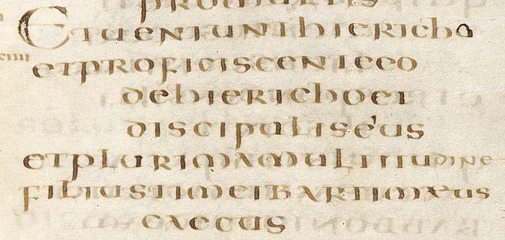Script Type : majuscule
Date : Late Roman, developed by the 4th century; in use until around the 8th century and continuing later for display headings
Location : Christian western Europe
Function : Formal book hand, originally for text of body of work, later for headings.





















Distinctive letters : The rounded M accompanied by the angular N are diagnostic. A has a loop rather than a crossbar. D is a simple curve with a backward sloping ascender. E and Q have shapes that we normally associate with minuscule letters. F is large and projects below the baseline.
As is usual in medieval script, I and J are identical, as are U and V, both of the latter having a rounded form.
There are occasional flourishes, as on X and G.
The rare letters K, Y and Z are not represented in this example and W is not found in Latin.
The letter forms of this script are easy for us to read as they are familiar enough. The difficulty comes from the fact that in this example, as is common but not universal, thare are no breaks between words. There are also some small letters which appear to have been interpolated into lines. Pass the cursor slowly over the first few lines to untangle the words. To examine the example in more detail, proceed to the paleography exercises.
Paleography
exercises for this example using Flash ![]()
Requires at least the Flash 5 plugin
If you are looking at this page without frames, there is more information about medieval writing to be found by going to the home page (framed) or the site map (no frames).